Pepper Steak
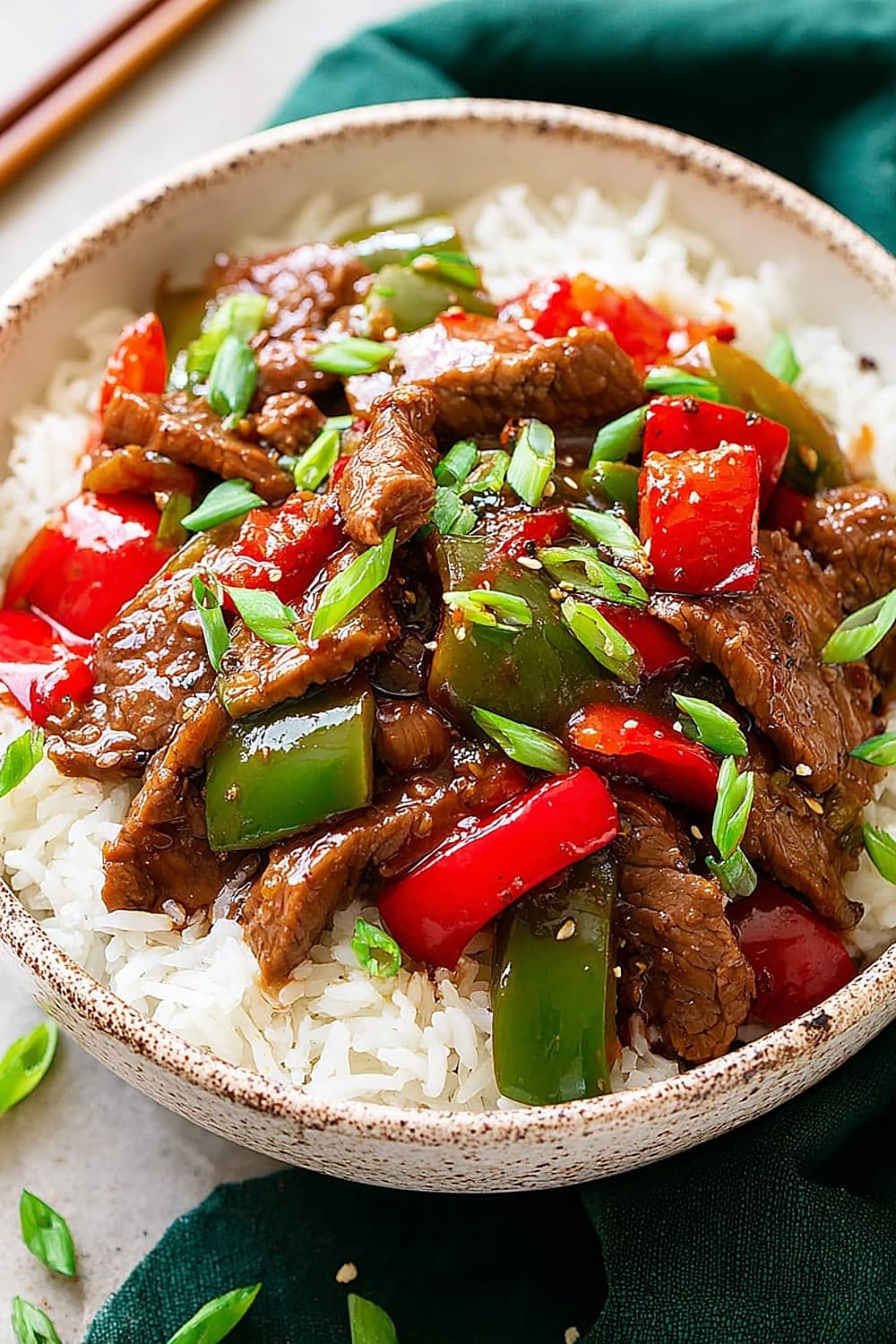
This pepper steak recipe is about to become your new weeknight superhero – the kind that swoops in when you need something impressive but don’t have three hours to spend in the kitchen.
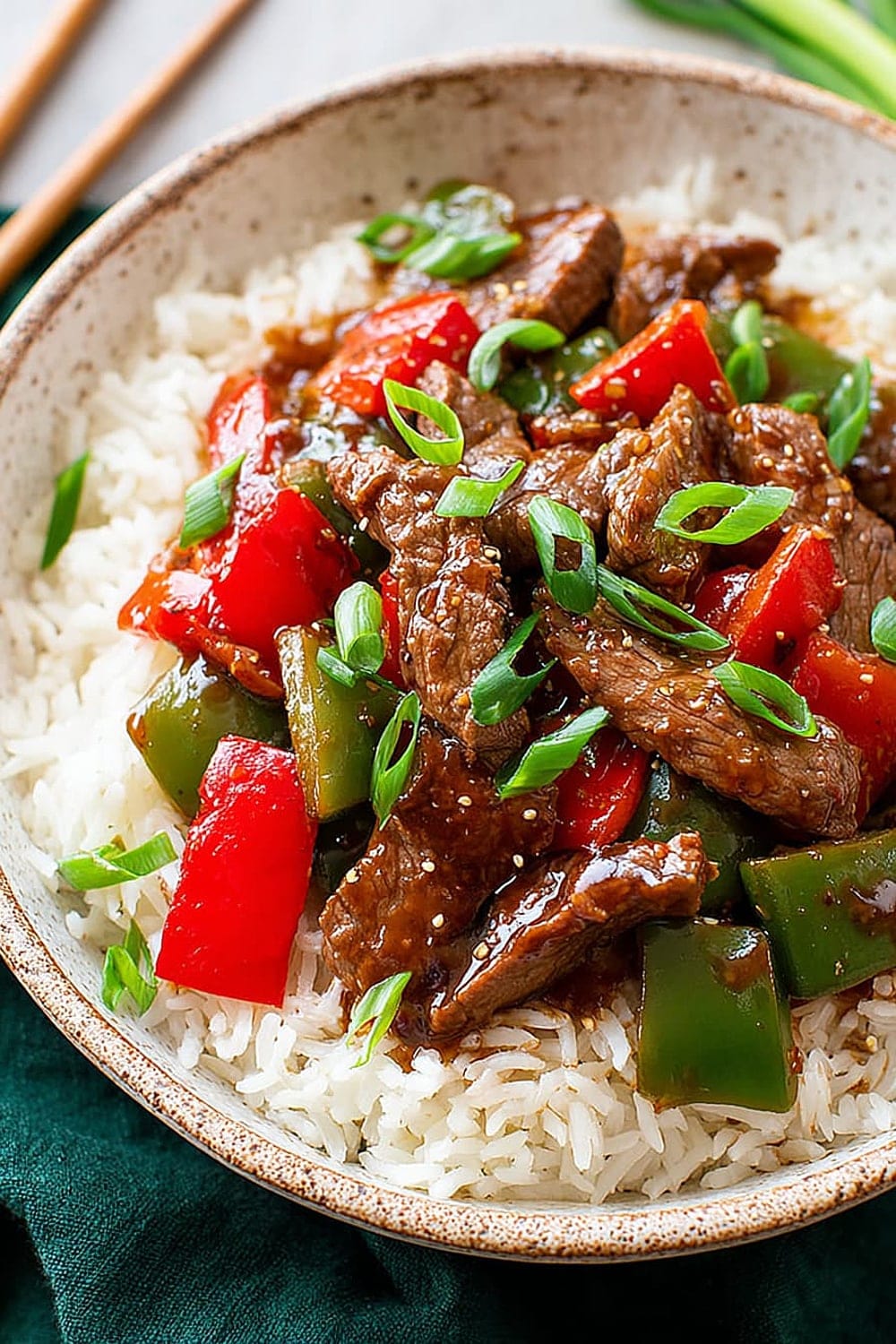
Picture tender strips of sirloin getting that perfect golden sear while bell peppers sizzle alongside, creating an aromatic symphony that’ll have your neighbors wondering what magic you’re working over there.
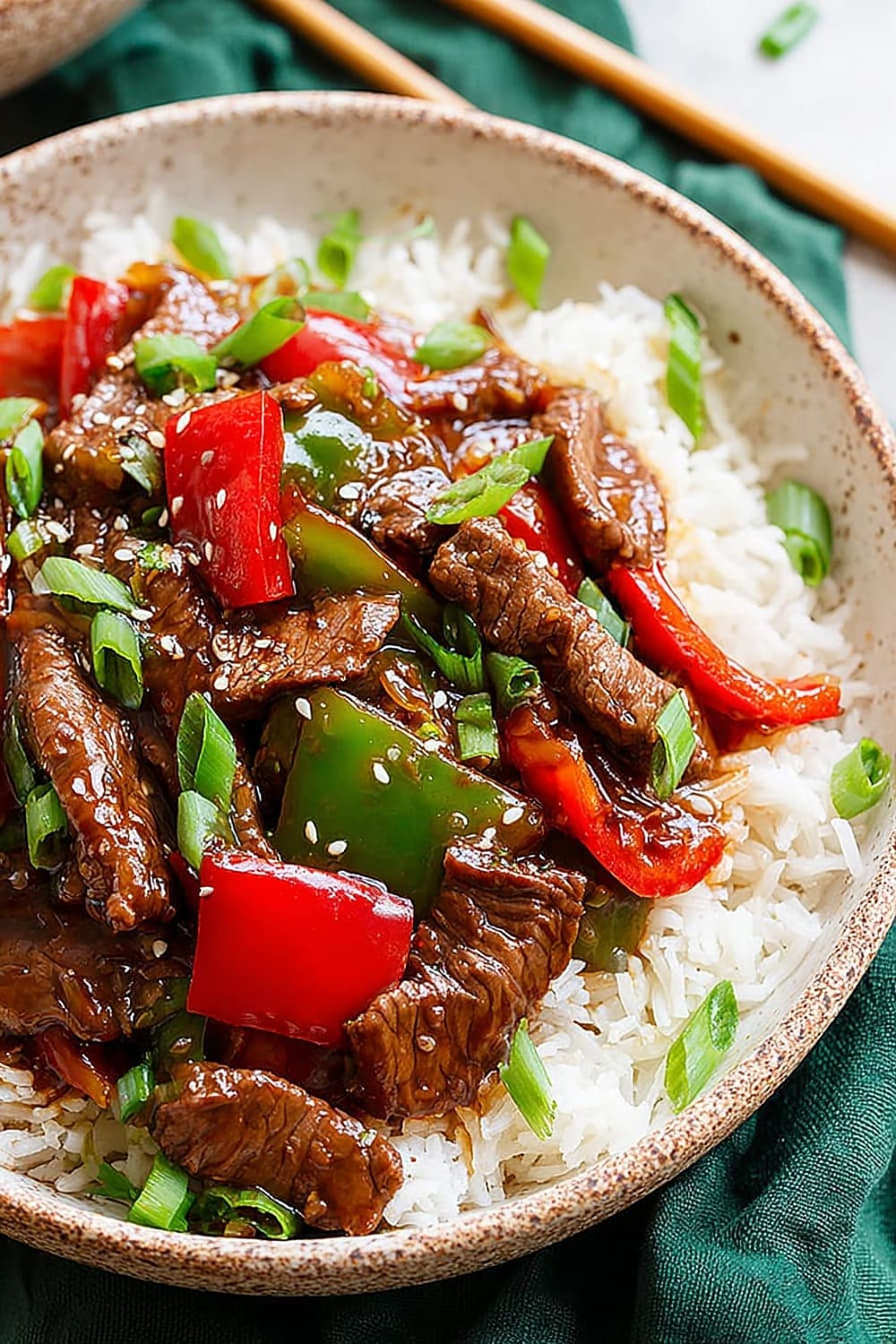
The secret weapon here is that glossy, savory sauce made with shaoxing wine and dark sesame oil that coats every piece of beef like liquid velvet.

This isn’t your average stir-fry situation – we’re talking restaurant-quality results that happen in your own kitchen, using a simple cast iron skillet or non-stick pan.
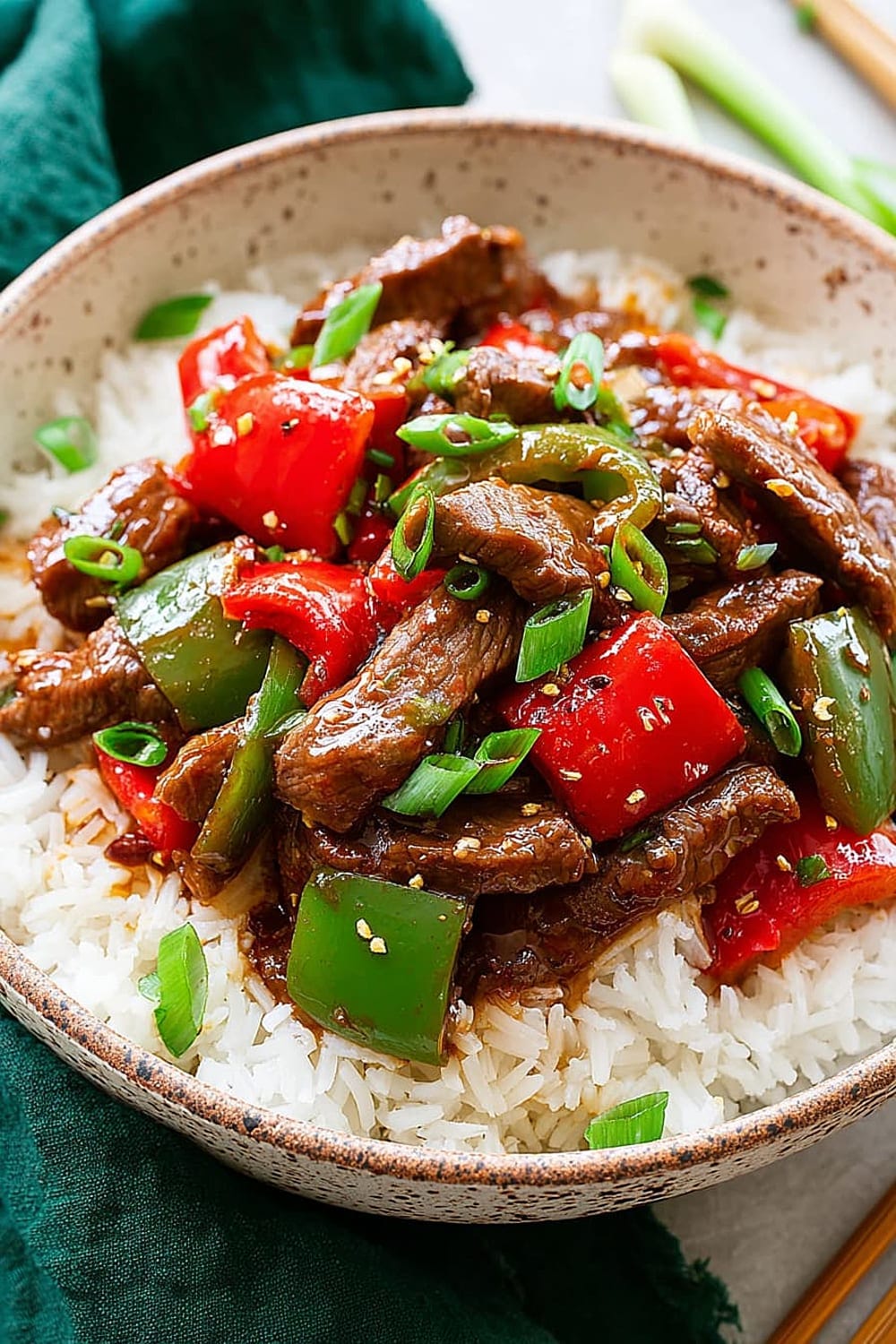
The whole thing comes together in just 30 minutes, but tastes like you’ve been slow-cooking all day long.
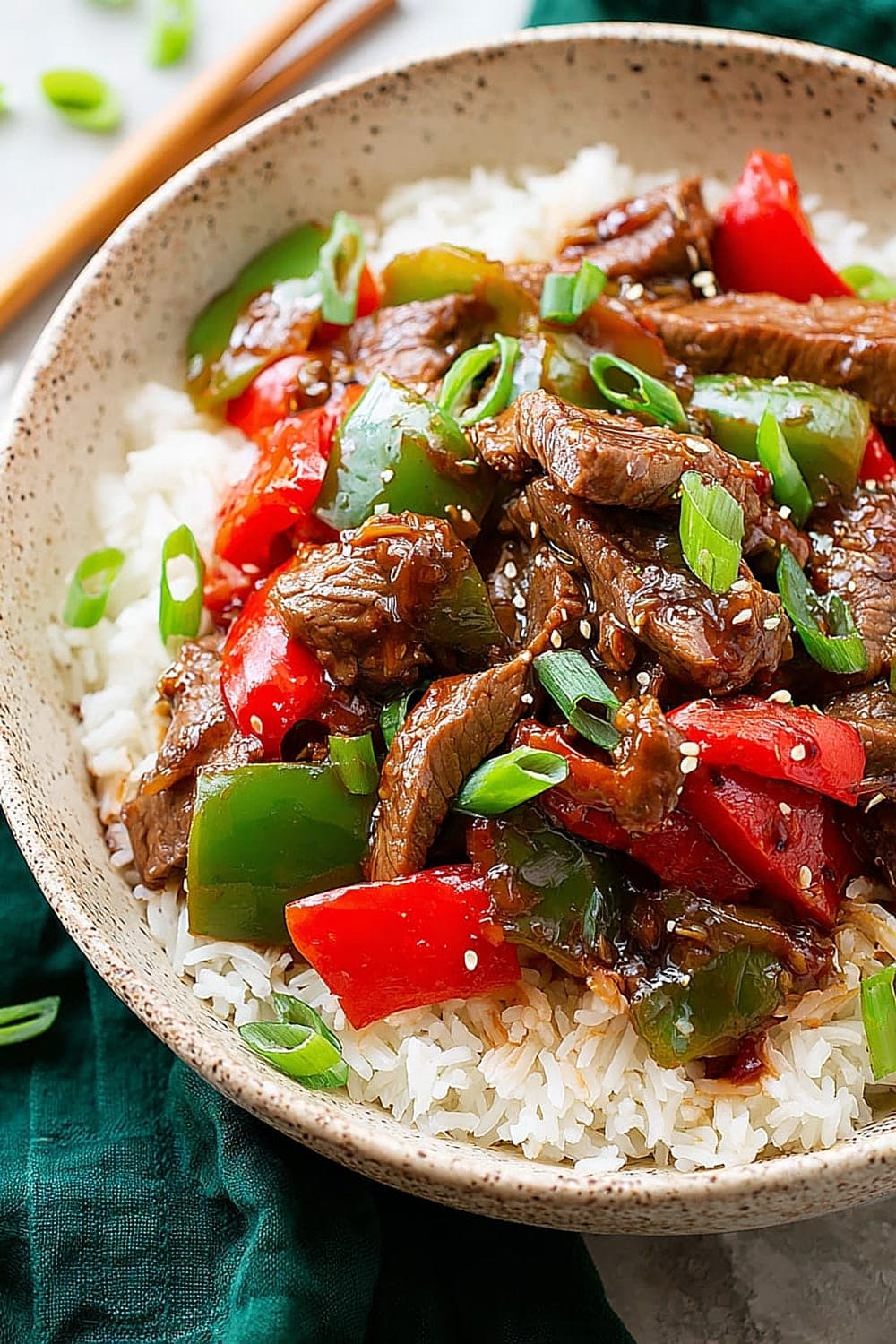
Fair warning: making this will result in people asking for the recipe, and you’ll get to casually mention how “easy” it was while secretly feeling like a culinary genius.
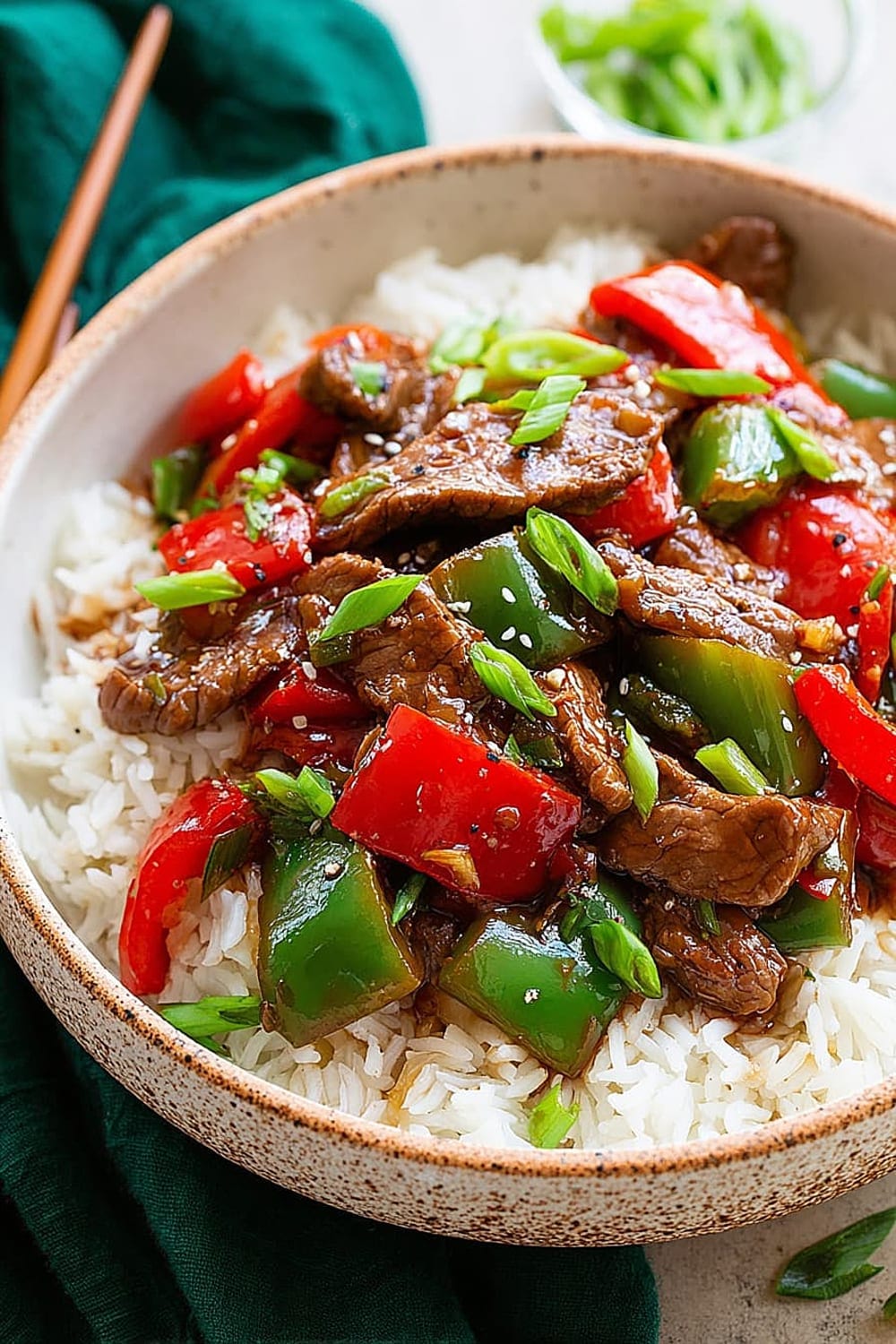
Ingredients
For the Steak
- 1 1/4 lbs. top sirloin steak (or upgrade to grass-fed for premium flavor)
- Salt to taste
- 6 tsp vegetable oil, divided
For the Vegetables
- 1 red bell pepper, chopped into bite-size pieces
- 1 green bell pepper, chopped into bite-size pieces
- 6 green onions, white portions sliced, green portions chopped into 2-inch pieces
- 1 Tbsp minced fresh garlic
- 1 Tbsp peeled and minced fresh ginger
For the Sauce
- 1 /3 cup low-sodium chicken broth
- 1 /4 cup shaoxing wine (essential for authentic flavor)
- 3 Tbsp soy sauce
- 1 Tbsp rice vinegar
- 1 Tbsp granulated sugar
- 2 tsp cracked black pepper
- 2 tsp dark sesame oil
- 1 Tbsp cornstarch
Instructions
Prepare the Steak
- 1 Place steaks on a cutting board and cover with plastic wrap. Using the flat side of a meat mallet, pound gently to help flatten slightly and tenderize the meat. This step breaks down tough fibers and ensures even cooking throughout.
- 2 Cut steak into 1/3-inch thick strips about 2-inches long. Pat the steak completely dry with paper towels and separate any pieces that are sticking together. Removing excess moisture is crucial for achieving that perfect sear – wet meat steams instead of browning.
Make the Sauce
- 3 In a mixing bowl, whisk together chicken broth, shaoxing wine, soy sauce, rice vinegar, granulated sugar, black pepper, sesame oil, and cornstarch until completely smooth. The cornstarch should be fully dissolved with no lumps remaining. Set this sauce mixture aside, but remember to whisk it again before adding to the pan.
Cook the Steak
- 4 Preheat a 12-inch non-stick skillet over moderately high heat until it’s hot enough that a drop of water sizzles immediately. Drizzle in 2 tsp vegetable oil and add half the steak, quickly spreading the pieces apart into a single layer with space between each piece. Lightly season with salt. The key here is not overcrowding – this allows proper searing instead of steaming.
- 5 Let the steak sear for 45-60 seconds on the first side until nicely browned on the bottom. You’ll know it’s ready when the edges start to look cooked and the bottom releases easily from the pan. Quickly flip each piece and brown the opposite side for another 45-60 seconds. Transfer the cooked steak to aluminum foil or a plate.
- 6 Repeat the searing process with 2 more teaspoons vegetable oil and the remaining half of the steak. This two-batch approach ensures each piece gets proper contact with the hot pan surface, creating that restaurant-quality caramelization.
Finish the Dish
- 7 Add the last 2 teaspoons of oil to the now-empty skillet, keeping the heat at moderately high. Add both bell peppers and sauté, tossing only occasionally to allow for some browning, for 3-4 minutes until they’re slightly tender but still have a bit of crunch. Over-stirring prevents proper caramelization.
- 8 Add the green onions, minced garlic, and fresh ginger to the skillet. Sauté for 1 minute longer, stirring constantly to prevent the garlic from burning. You’ll smell the aromatic oils releasing – that’s your cue that it’s ready.
- 9 Give the sauce mixture another thorough whisk to recombine the cornstarch, then pour it into the skillet. Let the sauce cook, stirring occasionally, until it thickens and becomes glossy, about 1-2 minutes. The cornstarch will activate and create that signature silky coating.
- 10 Toss the cooked steak back into the skillet, stirring to coat every piece with the thickened sauce. Heat through for 30-60 seconds until everything is steaming hot. Serve immediately while the sauce is at its glossiest and the vegetables retain their vibrant color and slight crunch.
Recommended Equipment and Kitchen Tools
Recommended Tools (for best results)
- 12-inch non-stick skillet or cast iron skillet – The large surface area prevents overcrowding and ensures proper searing. A quality non-stick surface makes cleanup effortless after working with the sticky sauce
- Meat mallet – Essential for tenderizing the sirloin and creating uniform thickness for even cooking
- Sharp chef’s knife – Makes quick work of slicing the steak into uniform strips and chopping vegetables precisely
- Instant-read thermometer – While not essential for this recipe, it’s helpful for checking that your steak reaches your preferred doneness
Helpful Upgrades
- Digital kitchen scale – For precise measurements of ingredients, especially when scaling the recipe up or down
- Microplane grater – Creates perfectly minced fresh ginger with minimal effort and better texture than chopping
- Quality cutting board – A large, stable surface makes prep work safer and more efficient
- Silicone spatula – Perfect for stirring the sauce and scraping every bit from the mixing bowl
Nice-to-Have Options
- Wok – If you have one, it’s ideal for stir-frying and provides excellent heat distribution
- Small whisk – Makes combining the sauce ingredients smoother and more thorough
- Prep bowls – Organize all your ingredients mise en place style for smooth cooking flow
Recipe Variations and Dietary Modifications
Gluten-Free Adaptation
- Replace regular soy sauce with tamari or coconut aminos in the same quantity
- Substitute cornstarch with arrowroot powder using the same measurement for thickening
- Double-check that your chicken broth is certified gluten-free
- The shaoxing wine is naturally gluten-free, so no substitution needed there
Low-Carb/Keto Modifications
- Replace granulated sugar with 1 tsp erythritol or stevia equivalent
- Serve over cauliflower rice instead of traditional rice to keep carbs minimal
- Add extra vegetables like broccoli or snap peas to increase volume without carbs
- The cornstarch adds minimal carbs but can be reduced to 2 tsp if needed
Protein Variations
- Substitute with flank steak or beef tenderloin for different textures and flavors
- Try chicken thighs cut into strips for a more budget-friendly option
- Pork tenderloin works beautifully with the same cooking times
- For plant-based, use extra-firm tofu or seitan strips
Flavor Variations
- Add 1 tsp chili garlic sauce for heat and depth
- Include sliced mushrooms with the bell peppers for earthiness
- Swap red bell pepper for orange or yellow peppers for color variety
- Finish with toasted sesame seeds for extra crunch and nutty flavor
Nutritional Information and Health Benefits
Key Nutritional Highlights
This pepper steak delivers approximately 320 calories per serving with a powerful protein punch of 28 grams from the lean sirloin. The dish provides essential B-vitamins, particularly B12 and niacin, along with significant amounts of iron and zinc from the beef. Each serving contains about 4 grams of fiber from the colorful bell peppers and green onions, plus minimal added sugars thanks to the balanced sauce.
Health Benefits of Main Ingredients
The top sirloin steak provides complete protein with all essential amino acids needed for muscle maintenance and repair. Bell peppers are nutritional powerhouses, loaded with vitamin C (more than oranges!), vitamin A, and antioxidants like capsanthin that support immune function and eye health. Fresh ginger offers anti-inflammatory compounds called gingerols, which may help reduce muscle soreness and support digestive health. Garlic contains allicin, a sulfur compound with potential cardiovascular benefits and immune-supporting properties.
Dietary Considerations
This recipe is naturally gluten-free when made with tamari instead of soy sauce, and fits well into high-protein, low-carb eating patterns. The dish contains approximately 12 grams of carbohydrates per serving, making it suitable for moderate carb-conscious diets. It’s dairy-free as written and provides a good balance of macronutrients for sustained energy.
Smart Swaps and Ingredient Substitutions
Common Substitutions:
- Shaoxing wine → Dry sherry or rice wine vinegar (use 3 Tbsp sherry + 1 Tbsp water)
- Dark sesame oil → Regular sesame oil or toasted sesame oil for similar nutty flavor
- Fresh ginger → 1 tsp ground ginger (though fresh provides better flavor and texture)
- Rice vinegar → Apple cider vinegar or white wine vinegar in equal amounts
Budget-Friendly Swaps:
- Top sirloin → Chuck roast cut thin (requires longer marinating for tenderness)
- Fresh bell peppers → Frozen bell pepper strips (thaw and pat dry first)
- Low-sodium chicken broth → Regular broth diluted with water, or homemade stock
- Shaoxing wine → Additional chicken broth with 1 tsp rice vinegar for depth
Pantry Emergency Substitutions:
- Cornstarch → All-purpose flour (use 2 Tbsp instead of 1 Tbsp)
- Soy sauce → Worcestershire sauce mixed with salt (different flavor profile but umami-rich)
- Green onions → Regular yellow onion diced small, or chives for garnish
- Vegetable oil → Any neutral oil like canola, avocado, or grapeseed oil
Pro Tips for Substitutions:
- When using frozen vegetables, increase cooking temperature slightly to evaporate excess moisture
- Ground spices are more concentrated than fresh – always use less and taste as you go
- Store opened shaoxing wine in the refrigerator for up to 6 months for best flavor
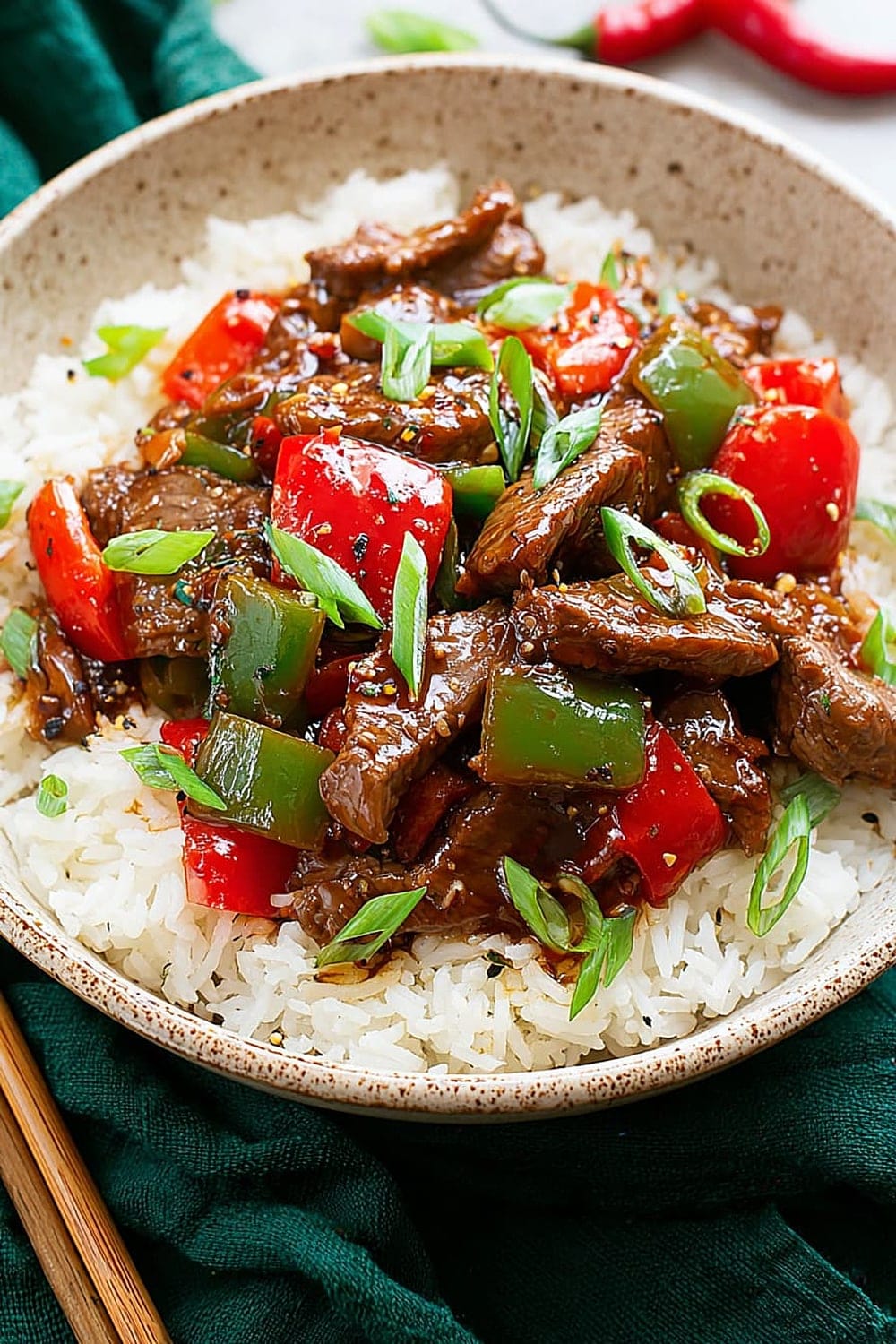
Make It Diabetes-Friendly
Sugar Substitutions:
- Replace 1 Tbsp granulated sugar with 1 tsp erythritol or 5-6 drops liquid stevia
- Monk fruit sweetener works excellently – use 1 tsp to replace the sugar
- Consider eliminating sweetener entirely and adding 1 Tbsp rice vinegar for tangy balance
- Total carb reduction: Approximately 12 grams less per batch
Portion & Timing Tips:
- Stick to 4-5 oz cooked beef per serving for optimal protein without excess calories
- Estimated carbs per serving: 8-10 grams (mainly from vegetables and sauce)
- Pair with cauliflower rice instead of regular rice to keep total meal carbs under 15 grams
- Add extra non-starchy vegetables like broccoli or snap peas to increase volume and fiber
Blood Sugar Management:
- The high protein content helps slow glucose absorption and maintain steady blood sugar
- Fiber from bell peppers further moderates blood sugar response
- Consider eating this dish mid-meal rather than on an empty stomach
- Healthy fats from sesame oil provide satiety and help with nutrient absorption
Smart Serving Strategies:
- Start with a small green salad to add fiber and slow digestion
- Include 1/4 avocado on the side for healthy fats and additional fiber
- Total meal carbs: Can stay under 20 grams when paired thoughtfully
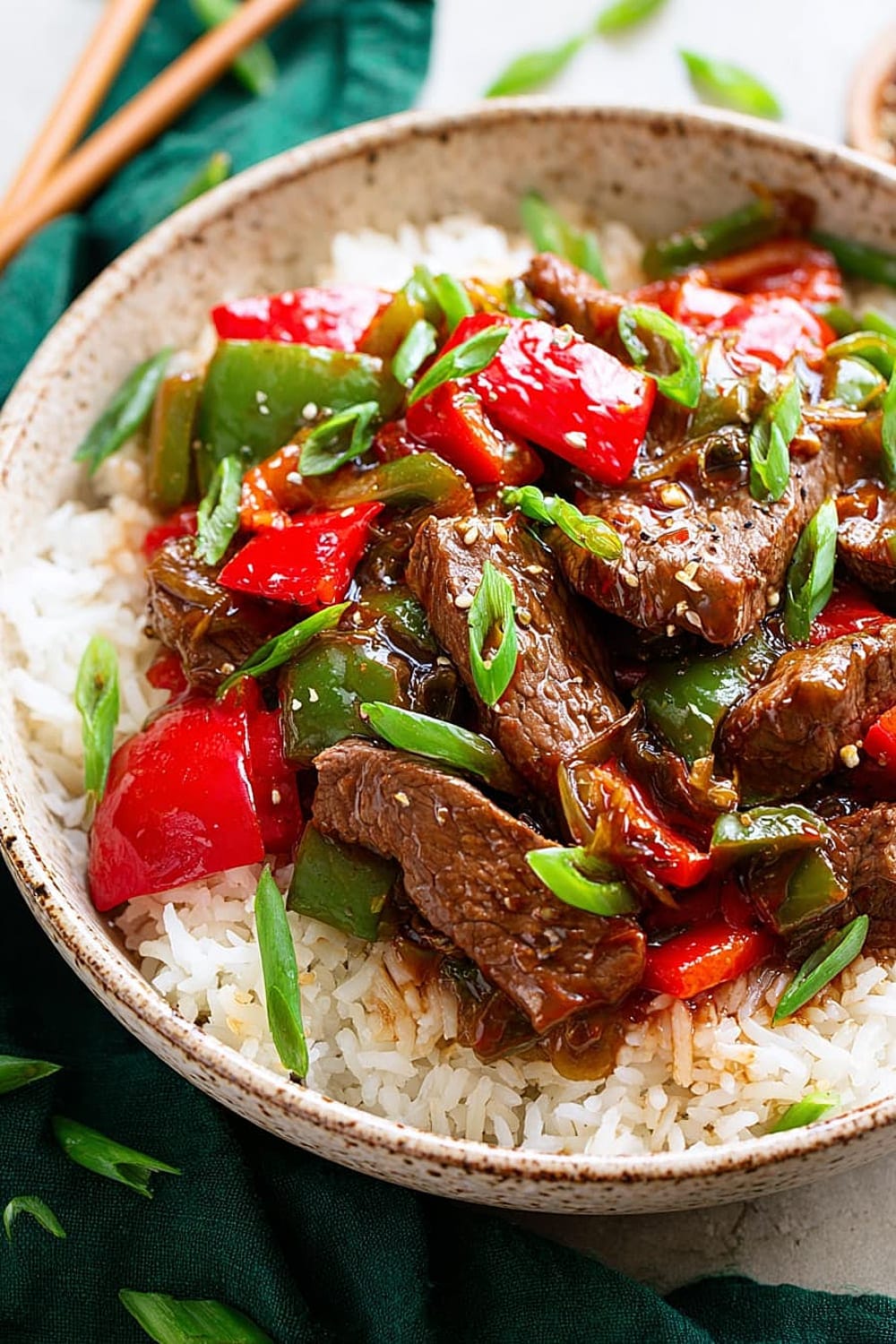
Perfect Pairing Suggestions
Beverage Pairings
A medium-bodied red wine like Merlot or Cabernet Sauvignon complements the rich, savory flavors of the beef beautifully. For beer lovers, try a crisp lager or wheat beer that won’t compete with the complex sauce. Jasmine tea or oolong tea makes an excellent non-alcoholic choice, echoing the Asian-inspired flavors. For something refreshing, sparkling water with lime cuts through the richness perfectly.
Side Dish Recommendations
Steamed jasmine rice or brown rice provides the perfect neutral base to soak up that glossy sauce. Cauliflower rice offers a low-carb alternative that still captures every drop of flavor. Stir-fried bok choy or Chinese broccoli adds complementary Asian flavors and contrasting textures. Sesame noodles turn this into a more substantial meal, while cucumber salad with rice vinegar provides a cool, crisp contrast to the warm, savory beef.
Complete Meal Ideas
Start with hot and sour soup or spring rolls to build an authentic Asian-inspired menu. Follow the pepper steak with coconut rice pudding or fresh fruit like sliced pineapple for a light finish. For entertaining, serve family-style with multiple vegetable stir-fries and steamed dumplings to create an impressive spread that encourages sharing and conversation.
Occasion Suggestions
This recipe shines for weeknight family dinners when you want something special but achievable. It’s perfect for casual entertaining since it cooks quickly and looks impressive. Date night at home becomes more romantic with this restaurant-quality dish, and it’s ideal for meal prep since it reheats beautifully for work lunches throughout the week.
Pro Tips and Troubleshooting
Professional Techniques
The key to restaurant-quality pepper steak lies in proper mise en place – have everything chopped, measured, and ready before you start cooking since the actual cooking happens fast. Velvet the beef by marinating strips in egg white and cornstarch for 20 minutes for incredibly tender results. Control your heat carefully – too low and you’ll steam instead of sear, too high and the garlic will burn before the vegetables are tender.
Common Mistakes and Solutions
Overcrowding the pan is the biggest culprit for soggy, gray beef instead of golden-brown pieces. Cook in batches and resist the urge to move the meat too quickly. Sauce separation happens when cornstarch isn’t properly dissolved – always whisk the sauce again right before adding it to the hot pan. Overcooked vegetables lose their vibrant color and crisp texture, so err on the side of slightly underdone since they’ll continue cooking in the hot sauce.
Storage and Reheating
Store leftovers in the refrigerator for up to 3 days in airtight containers. Reheat gently in a skillet over medium heat with a splash of chicken broth to revive the sauce consistency. Freezing works for up to 2 months, though the vegetables will be softer after thawing. Meal prep tip: Cook the beef and vegetables separately, then combine with fresh sauce when reheating for best texture.
Recipe Scaling
Double the recipe easily by using two pans simultaneously or cooking in larger batches. Halving works perfectly for smaller households – just use a smaller skillet to maintain proper heat distribution. When scaling up, increase cooking times slightly to ensure everything heats through properly, but don’t increase the searing time for individual pieces of beef.
This pepper steak proves that impressive doesn’t have to mean complicated – sometimes the best recipes are the ones that deliver maximum flavor with minimal fuss, leaving you more time to enjoy the compliments and less time stressed in the kitchen.